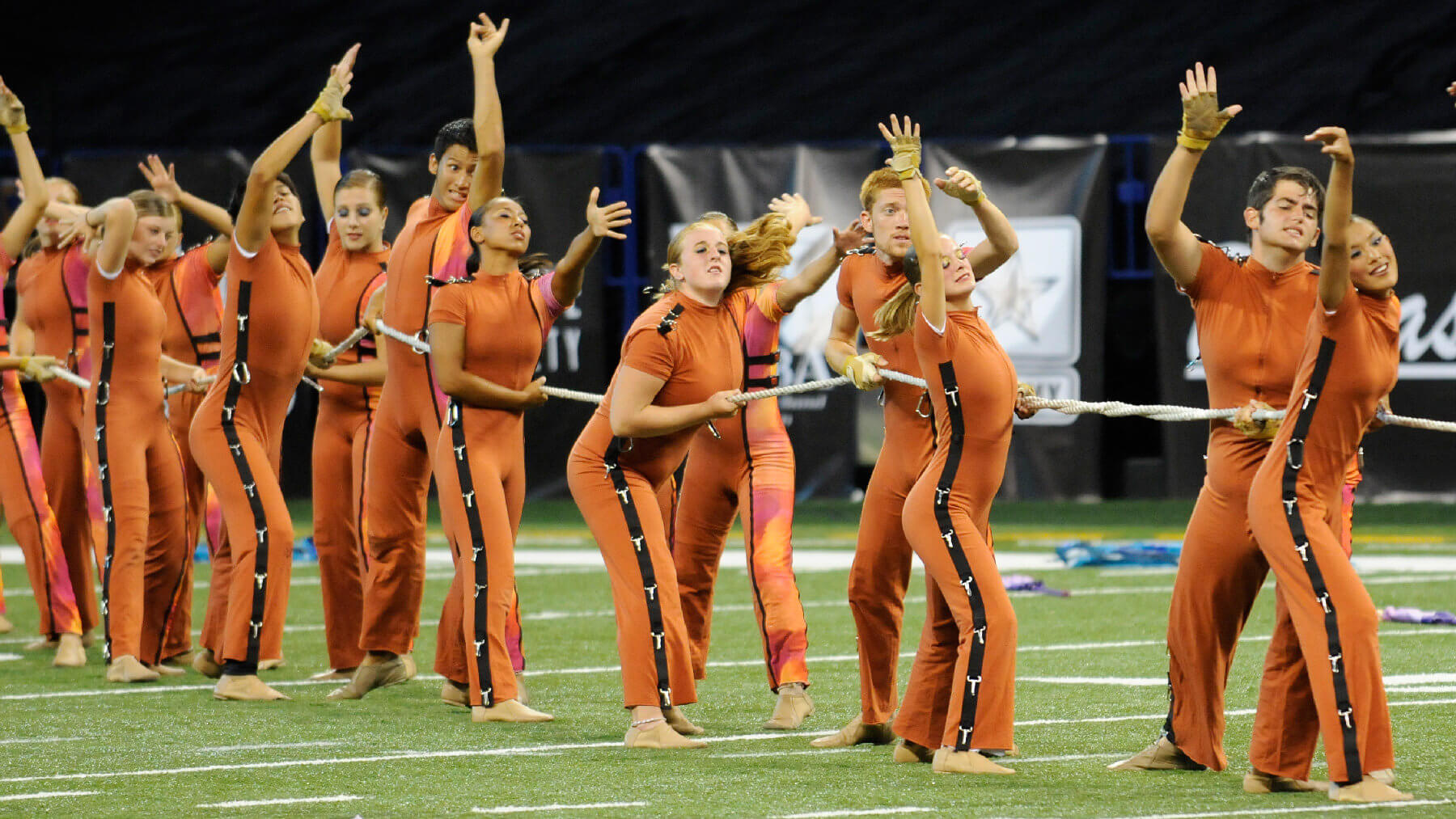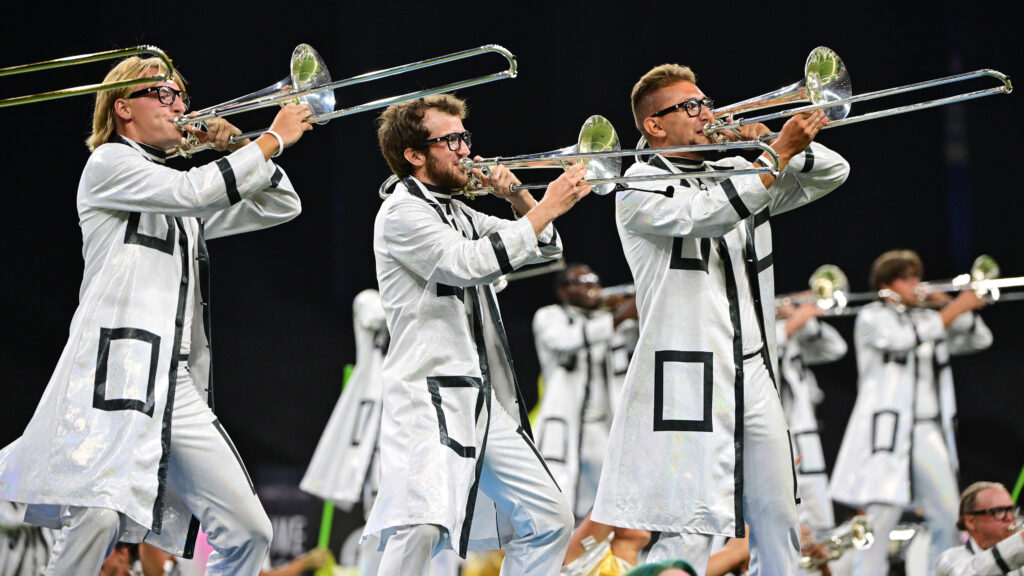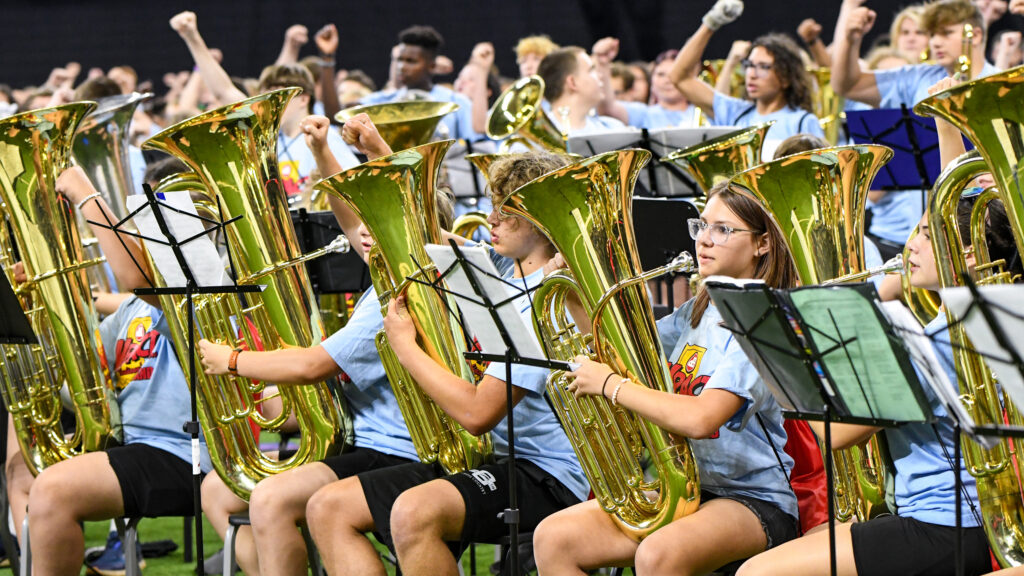The 2009 Drum Corps International World Championship was the first to be held inside Indianapolis’ brand-new Lucas Oil Stadium.
The very first Semifinals competition hosted in the stadium brought a lot of drama among the corps hoping to make the Finals competition. Colts were among the top 12 corps in four captions, but fell three-tenths of a point short of advancing to the Saturday show even after besting the finalist Troopers four times earlier in the season. The Academy, in 14th place, regained a spot in the Semifinals after falling out of the Friday show in 2008. The 15th place Madison Scouts found themselves out of Finals for the third time since 2002, followed by Crossmen and Spirit.
The Academy’s 2009 production titled, “The Ascent,” rediscovered a successful mix of sophistication and accessibility that seemed to elude the corps the previous year. The show literally and figuratively portrayed the quest of someone trying to reach a high mountain summit, though generally, any specific climber was more referenced than seen. But the show also symbolically portrayed people’s highest goals and the desire to experience something greater beyond their earthbound presence.
This opening to the show was set to “Call of the Mountain” from Joseph Curiale’s “Gates of Gold,” originally written for orchestra and recorded on Curiale’s 1994 album, “Awakening.” Curiale is a prolific composer for band and orchestra whose music has been performed by a number of DCI corps.

The Academy’s journey began in physical and spiritual isolation during “The First Ascent.” Members of the horn line looked upward to the peak of the mountain, seeming to reflect on the arduous journey about to be undertaken. The color guard members, in a single line, held on to and pulled up on a length of thick climbing rope that stretched diagonally across most of the field. At the climax of the opening statement, the horns, outlining a mountain ridge, turned and let loose a loud chord that if played on the side of a snowy mountain, would have threatened to provoke an avalanche.
At the end of the piece, two sections of brass players in inverted “V” forms representing mountaintops crossed through each other, ending in one giant block inverted “V” representing the peak of the mountain. Three color guard members up front pulled against a rope and helped each other to ascend the formation.
The show then progressed into a segment titled “The Storm,” based on the 1815 tone poem “An Alpine Symphony” by Richard Strauss, the late Romantic German composer best known to drum corps audiences for “Don Juan” and “Thus Spoke Zarathustra.” The work really isn’t a symphony, but 22 segments of music played without pause. Requiring 125 performers, it’s rarely performed in concert halls.
On the drum corps field, the work created the mood from twilight to just before dawn in the Alps, a setting so meaningful to Strauss that he built a home in Bavaria with a view of the mountains. As a youth, he was part of a group of climbers who got lost going up a mountain and got caught in a terrible storm, heard in the segment Strauss titled, “Gewitter und Sturm,” meaning “Thunder and Tempest.” Thunder sheets in the front ensemble percussion section accompanied this segment. Physical obstacles portrayed in the drill formations were intended to lead the climber to contemplate the wisdom of continuing the quest.
Wracked with indecision, the climber received encouragement from others pushing toward the peak during “Lifeline” (based on the segment Strauss titled, “On the Summit”). These actions gave the climber increased motivation and a second wind of energy. During the poignant chorale, horn soloists were attached to color guard members by climbing straps that served to help them in the continued ascent. This selection ended with a block triangle pointing up, another visual reference to the mountain peak.
To music of John Mackey’s 2007 work, “Kingfishers Catch Fire,” the joy of accomplishment was heard in “The Final Ascent.” The work was commissioned by a consortium of seven high school, university, and community bands in Japan, and was written about the colorful bird whose bright feathers appear to be on fire when viewed in bright light.
Mackey’s vibrant musical colorings were a perfect vehicle for representing the sense of elation felt when reaching the top of the mountain. A single guard member climbed ladder-like rungs attached to a pole and triumphantly stretched out toward the heavens. The only thing higher than her was sky, with the surrounding solid white flags alluding to the snowcapped peak of the mountain.
Seconds before the end of the show, the horns and drums formed a giant arrow pointing to the upper right corner of the field in an “onward and upward” form representing not only the achievement of reaching the top, but also the triumph of realizing one’s lofty goals.
For this week only, you can save on the DVD that contains this complete Academy performance, along with all corps from Volume II of the 2009 DCI World Championship DVD set.
Buy the 2009 Volume II DCI World Championship DVD.
(Available this week only for 20% off)
DVD discount offer ends Monday, June 29, 2015.

Michael Boo was a member of the Cavaliers from 1975-1977. He has written about the drum corps activity for more than a quarter century and serves as a staff writer for various Drum Corps International projects. Boo has written for numerous other publications and has published an honors-winning book on the history of figure skating. As an accomplished composer, Boo holds a bachelor's degree in music education and a master's degree in music theory and composition. He resides in Chesterton, Indiana.





